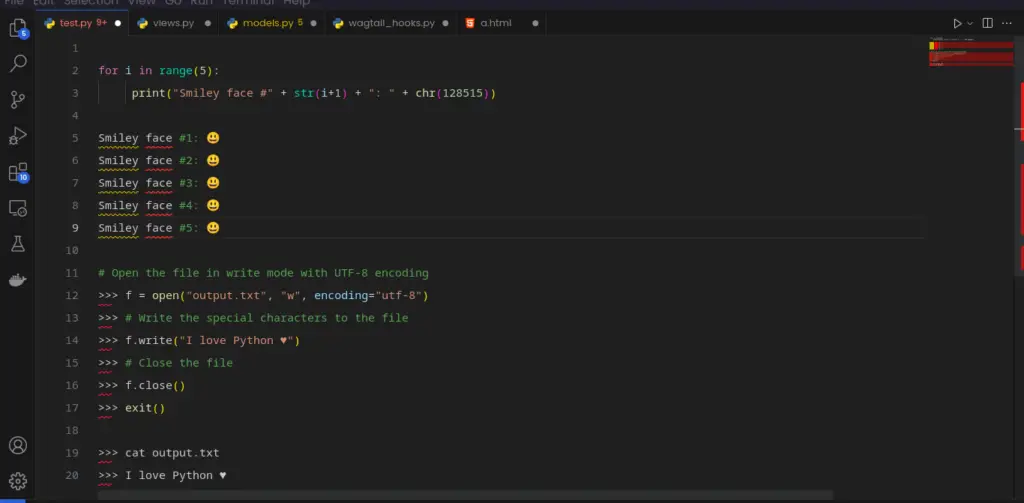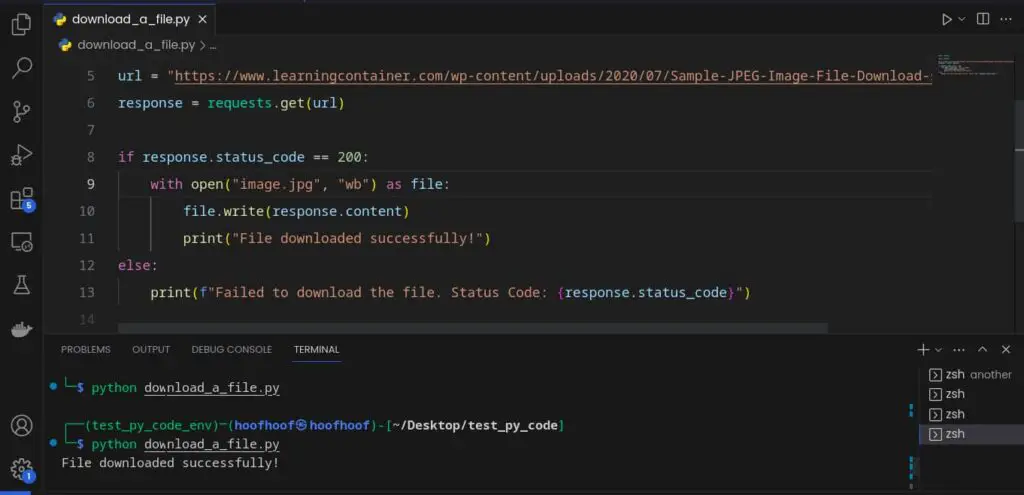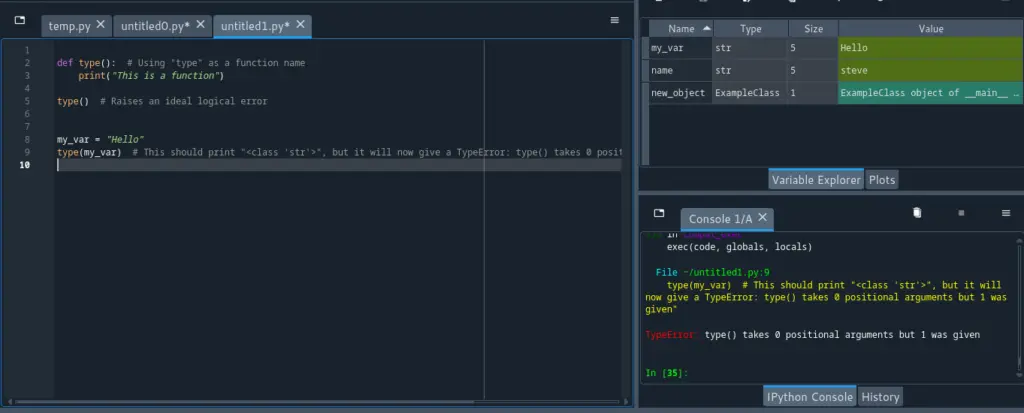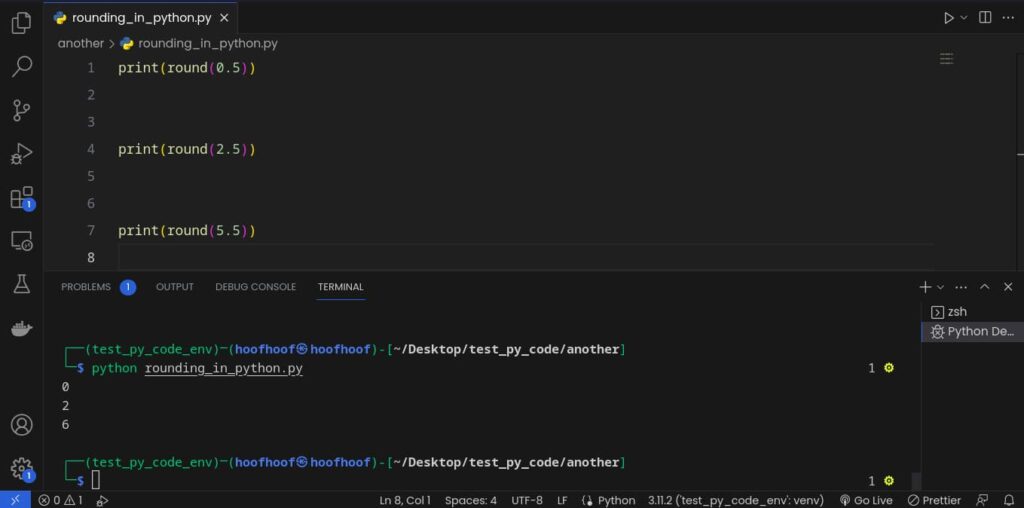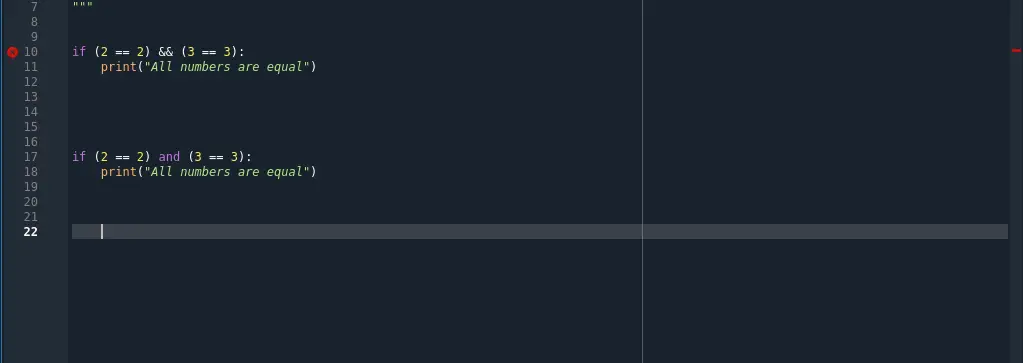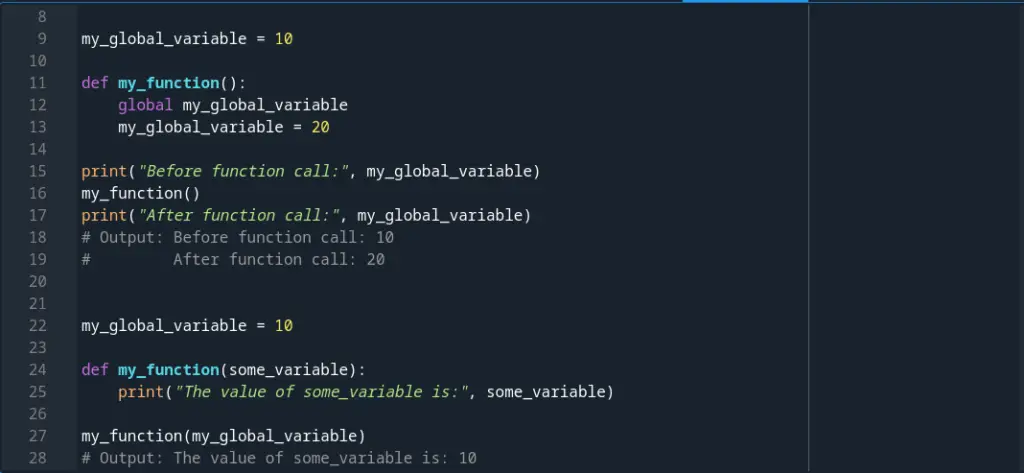When working with data, there are instances where we only require whole number integers rather than dealing with decimal values.
This need becomes particularly evident when handling non-divisible items, where working with floating point numbers would yield nonsensical results.
However, it’s important to note that even after manipulating the inputs or operands, floating point numbers may still arise.
In such cases, an effective approach is to utilize a division operation that consistently produces integer results, irrespective of any floating point values that may emerge.
To do such a division, Python provides a powerful mathematical operation known as floor division.
So, in this article, we’ll focus on,
What is floor division in Python?
Floor division in Python is a mathematical operation that allows you to divide two numbers and obtain the closest whole number integer as the result. It is denoted by the “//” operator.
Floor division differs from regular division because it always rounds down to the nearest integer, regardless of any fractional part.
To understand floor division better, let’s break it down:
- Whole number integers: Floor division is useful when we only need whole number integers in our calculations, such as counting items or dividing quantities that cannot be evenly divided.
- The “//” operator: In Python, we use the “//” operator to perform floor division. It separates the dividend (the number being divided) from the divisor (the number dividing the dividend).
- Rounding down: Floor division always rounds down to the nearest whole number. It disregards any fractional part of the result. This is particularly important when we want precise integer values for our computations.
To illustrate the difference between floor division and regular division, consider the following example:
# Regular division
result = 7 / 3
print(result) # Output: 2.3333333333333335
# Floor division
result = 7 // 3
print(result) # Output: 2
In the regular division, the result is a floating point number with a fractional part.
However, in floor division, the fractional part is discarded, and we obtain the nearest whole number integer as the result.
Comparing Floor Division and Regular Division:
| Operation | Example | Result |
|---|---|---|
| Regular Division | 7 / 3 | 2.3333333 |
| Floor Division | 7 // 3 | 2 |
As you can see from the comparison table, floor division gives us a precise whole number integer result, while regular division includes the fractional part.
In short, floor division is a fundamental operation in Python that allows us to obtain whole number integers when dividing two numbers.
It helps us maintain accuracy and relevance in our computations, especially when working with non-divisible items or situations that demand integer results.
By using the “//” operator, we can easily implement floor division in our code and ensure that our calculations align with the nature of the data we are working with.
I hope you understand now what floor division is and why it’s important in certain situations.
Now, let’s dive into the practical aspect of performing floor division in Python.
Don’t worry, it’s quite straightforward!
To perform floor division in Python, you can do in two ways/approaches:
- Using the math.floor() function
- Using the // operator which call the __floordiv__() magic method
Let’s see each approach.
Using math.floor() function to do floor division in Python
The math.floor() method in Python is a function available in the math module that takes a single argument (a number) and returns the largest integer that is less than or equal to the given number. It essentially rounds down the value to the nearest whole number integer.
Python provides math.floor() method to perform floor division.
This function is part of the math module, which offers various mathematical operations and functions.
The math.floor() function takes a single argument (the number being divided) and returns the largest integer less than or equal to the input value.
To utilize the math.floor() function for floor division in Python, follow these steps:
1. Import the math module
Before using the math.floor() function, import the math module at the beginning of your code.
This allows you to access the functions and operations provided by the module.
import math2. Identify the dividend and divisor
Determine the numbers you want to divide.
The dividend is the number being divided, and the divisor is the number dividing the dividend.
dividend = 11
divisor = 73. Perform division using the regular division operator
Divide the dividend by the divisor using the regular division operator (“/”).
This operation will produce a floating-point result with the potential for a fractional part.
result = dividend / divisor
4. Apply the math.floor() function
Pass the result of the division to the math.floor() function, which will round down the value to the nearest whole number integer.
result = math.floor(result)
5. Print or use the result
You can now print the result or use it in further calculations based on your requirements.
print(result)
Here’s a screenshot that ties it all:
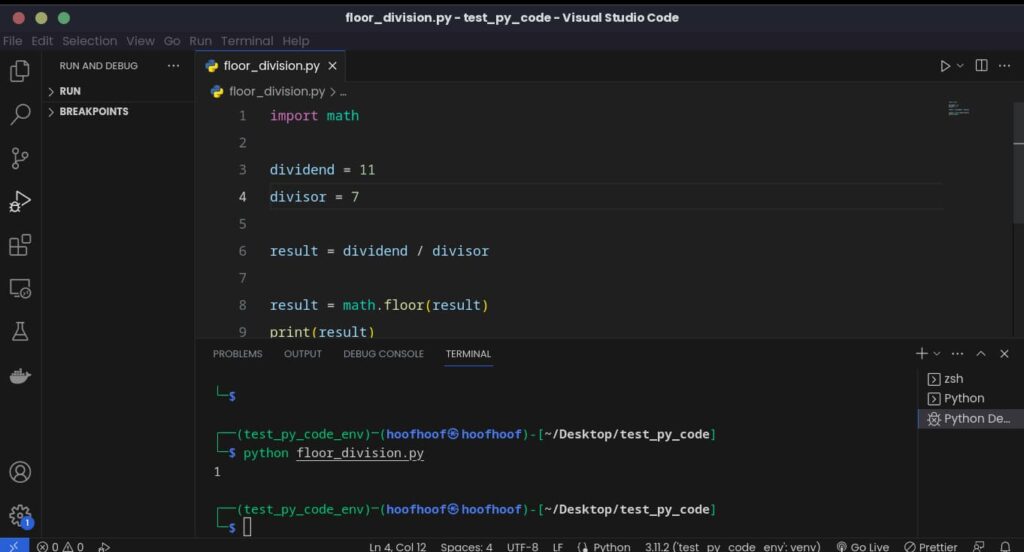
Using the math.floor() function allows for more flexibility in complex calculations that involve additional mathematical operations.
It ensures that the result is always rounded down to the nearest whole number, aligning with the concept of floor division.
That’s how you can achieve floor division in Python using math.floor() method.
Now, let’s see how you can use the shorter alternative, // operator to do the same floor division operation.
But, before we do,
What does // mean in Python?
// operator in Python allows you to perform floor division on the inputs producing integers. Floor division divides two operands, and the result is always rounded down to the nearest integer.
In Python, the “//” operator represents the floor division operation.
Floor division allows us to divide two numbers and obtain the closest whole number integer as the result.
It discards any fractional part of the division, always rounding down to the nearest whole number.
Let’s break down the usage and behavior of the “//” operator:
How to use the // operator for floor division in Python
Performing floor division in Python is a breeze with the help of the “//” operator.
Let’s explore step-by-step how you can use this operator to achieve floor division in your code.
Step 1: Identify the Dividend and Divisor
To begin, determine the numbers you want to divide.
The dividend is the number being divided, and the divisor is the number dividing the dividend.
Make sure you have these values ready before proceeding.
As an example, let’s consider numbers 23 and 8.
So,
dividend = 23
divisor = 8Step 2: Apply the // Operator
Once you have the dividend and divisor, you can apply the “//” operator to perform floor division.
This operator indicates that you want to obtain the nearest whole number integer as the result of the division.
Simply place the “//” operator between the dividend and the divisor.
With our example, it should look like this:
dividend // divisor
Step 3: Assign or Print the Result
If you wish to store the result for later use, you can assign it to a variable using the assignment operator “=” and a proper variable name.
This step is optional, and you can skip it if you only need to display the result without storing it.
result = dividend // divisorStep 4: Use the result in other parts of your Python code or Print the Result
Upon assigning the results to a variable, you can then use the results of the floor division later on in your code.
Now, let’s put these steps into action with an example:
# Step 1: Identify the dividend and divisor
dividend = 23
divisor = 8
# Step 2: Apply the // operator for floor division
result = dividend // divisor
# Step 3: Print or use the result
print(result) # Output: 2
In this example, we have a dividend of 23 and a divisor of 8. By using the “//” operator in step 2, we perform floor division and obtain the result 3.
You can assign the result to a variable, as shown in step 3, or directly print it to the console.
Let’s do another example, to make it solid for you:
The syntax of doing a floor division for 5 and 2 in Python
floor_div = 5 // 2The results
print(floor_div)
2After floor division, it should make sense to produce 2 because it is also correct mathematically. 5 floor divided 2 will always produce 2.
Let’s see another example where a division will produce results that, when rounded to the nearest, will jump to the upper value.
For example, it is common to round off 3.75, always to be 4.
However, with floor division, the 3.75 is always rounded down to 3 instead of 4.
A normal division of 19 and 5 produces 3.8
normal_div = 19 / 5
print(normal_div)
# result
3.8However, 3.8 results to 3 with a floor division
floor_div = 19 // 5
print(floor_div)
# result
3Floor division in Python does not always work with whole numbers. You can also use // with floating point numbers to produce integers.
Here’s an example of a floor division involving floats
floor_div_with_floats = 19.5 // 5
print(floor_div_with_floats)The result
3.0You can also use two floating point operands in a // floor division in Python.
floor_div_with_floats = 19.5 // 5.5
print(floor_div_with_floats)Result
3.0That is the purpose of // in Python.
In summary, the // operator works by invoking the __floordiv__() magic method that is used to perform floor division in Python.
How does floor division differ from regular division?
Floor division and regular division may seem similar at first glance, but they have distinct differences that are important to understand.
Let’s explore how floor division sets itself apart from regular division in Python.
Difference based on the result type
- Regular Division: Regular division can produce both whole number integers and fractional results, depending on the input values. The result is typically a floating-point number.
- Floor Division: Floor division, on the other hand, always produces a whole number integer as the result. It rounds down to the nearest whole number, discarding any fractional part.
Difference based on Handling of the fractional part
- Regular Division: Regular division retains the fractional part of the result. This means that even if the division yields a value with a decimal component, it will be included in the output.
- Floor Division: Floor division completely disregards the fractional part of the result. It focuses solely on the integer value, rounding down to the nearest whole number.
To highlight the difference between floor division and regular division, let’s compare the two using an example:
| Operation | Example | Result |
|---|---|---|
| Regular Division | 17 / 5 | 3.4 |
| Floor Division | 17 // 5 | 3 |
As you can see from the comparison table, regular division gives a floating-point result with a fractional part, while floor division using the “//” operator rounds down to the nearest whole number.
And with a code example:
# Regular division
result = 7 / 3
print(result) # Output: 2.3333333333333335
# Floor division
result = 7 // 3
print(result) # Output: 2
In the above example, we divide 7 by 3 using both regular division and floor division. As a result of regular division, we obtain 2.3333333333333335, which includes the fractional part.
However, floor division gives us a rounded-down whole number of 2, discarding the fractional part.
Understanding the differences between floor division and regular division is crucial when you need precise integer results or when dealing with situations that demand whole numbers.
By choosing the appropriate division method based on your specific requirements, you can ensure accurate and meaningful computations in your Python programs.
How does floor division handle negative numbers?
When performing floor division in Python and working with negative numbers, it is important to pay attention to ensure that the results obtained are accurate.
Handling negative numbers in floor division requires careful consideration due to the rounding behavior involved.
Floor division works by rounding down to the nearest whole number.
However, when negative numbers are involved, there are specific rules to follow to obtain the expected results.
When only positive numbers are involved in a floor division operation, the behavior is straightforward.
The result is rounded down to the nearest whole number, as we have seen in previous examples.
However, when negative numbers are introduced, the rounding behavior becomes more complex.
In floor division, the presence of a negative number in the dividend or divisor can affect the result.
The key aspect to understand is that floor division rounds towards negative infinity.
This means that when negative numbers are involved, the result becomes more negative.
For example, if we have a negative dividend and a positive divisor, the result of the floor division will be more negative than if we had positive numbers.
Similarly, when the dividend is positive and the divisor is negative, the result will also be more negative.
However, if both the dividend and the divisor are negative, the result of the floor division becomes positive.
This is because the rounding down behavior still applies, resulting in a positive whole number.
To better understand the behavior of floor division with negative numbers, let’s consider some examples:
Example 1: Floor division with positive numbers
result = 7 // 3
print(result) # Output: 2
In this case, both the dividend (7) and the divisor (3) are positive. The floor division gives us a result of 2, as discussed earlier.
Example 2: Floor division with a negative dividend
result = -7 // 3
print(result) # Output: -3
Here, the dividend (-7) is negative, while the divisor (3) remains positive. The result of the floor division is -3.
Notice that the result becomes more negative, rounding towards negative infinity.
Example 3: Floor division with a negative divisor
result = 7 // -3
print(result) # Output: -3
In this example, the dividend (7) is positive, but the divisor (-3) is negative. The floor division once again gives us -3 as the result.
The result remains the same as when the dividend was negative, rounding towards negative infinity.
Example 4: Floor division with both negative dividend and divisor
result = -7 // -3
print(result) # Output: 2
When both the dividend and the divisor are negative (-7 and -3, respectively), the floor division produces a positive result of 2.
This behavior aligns with rounding down towards negative infinity.
To summarize, floor division handles negative numbers by rounding towards negative infinity.
When only one of the numbers is negative, the result becomes more negative.
However, when both the dividend and divisor are negative, the result is positive. U
nderstanding these rules ensures accurate calculations when dealing with negative numbers in floor division operations.
Handling negative numbers in floor division requires attention because it affects the final result and can lead to unexpected outcomes if not considered correctly.
It is crucial to understand the rounding behavior and follow the rules to ensure accurate results in calculations involving negative numbers.
By being mindful of the rules and properly managing negative numbers in floor division operations, Python programmers can obtain the intended results and maintain accuracy in their computations.
By following these simple steps, you can confidently use the “//” operator for floor division in Python.
Whether you’re working with non-divisible items or require precise integer results, floor division is a valuable tool to ensure accuracy in your computations.
Advantages of using floor division in Python
Floor division in Python offers several advantages that make it a valuable tool in programming.
Here’s how:
- Obtaining precise integer results: Floor division ensures that we always obtain whole number integers as results, even when dealing with numbers that are not evenly divisible. This level of precision is particularly useful in scenarios where fractional values are irrelevant or undesirable.
- Consistency in calculations: Floor division provides consistent results by rounding down to the nearest whole number. This consistency helps maintain accuracy and predictability in computations, especially when working with data that requires integer values.
- Handling non-divisible items: When working with items that cannot be divided evenly, such as counting items or allocating resources, floor division ensures that we obtain integer values that align with the nature of the problem. This makes it easier to perform calculations and make decisions based on whole number quantities.
- Simplifying algorithms and conditions: Floor division can simplify algorithms and conditions by reducing the need for complex rounding or checking for remainders. By using floor division, we can directly obtain integer results without additional calculations or checks, making the code more concise and efficient.
What are your thoughts on these examples, give me some feedback:
Obtaining precise integer results:
Let’s say you are managing a warehouse where items are stored in boxes.
Each box can hold a maximum of 10 items. If you have 35 items to distribute among the boxes, using floor division allows you to calculate the exact number of boxes needed.
The result will be the precise integer value without any fractions, ensuring accurate allocation and avoiding the need for partial boxes.
Consistency in calculations:
Imagine you are developing a financial application that calculates monthly loan payments.
If the monthly payment needs to be split equally among multiple borrowers, floor division ensures that each borrower receives an equal whole number of payments.
This consistency ensures fairness in the distribution and avoids situations where one borrower may receive a slightly different payment amount due to rounding.
Handling non-divisible items:
Let’s consider a scenario where you are organizing a marathon and need to distribute a certain number of participants into teams of 5.
If you have 78 participants, floor division helps you determine the exact number of teams needed (in this case, 15 teams) and ensures that all participants are evenly distributed, even if the total number of participants is not divisible by 5.
Simplifying algorithms and conditions:
Suppose you are developing a scheduling application that assigns tasks to workers in shifts.
Each shift lasts for 8 hours, and you need to determine the number of shifts required to cover a certain number of total working hours.
By using floor division, you can directly calculate the number of shifts needed without additional checks or rounding calculations.
For example, if you have 48 total working hours, floor division by 8 will give you the exact number of shifts required (6 shifts).
These examples demonstrate how floor division in Python provides precise integer results, maintains consistency in calculations, handles non-divisible items effectively, and simplifies algorithms and conditions.
By incorporating floor division into your code, you can solve real-world problems more accurately and efficiently.
Now, let’s look at some common mistakes most Python programmers make and how to avoid them.
Common pitfalls and mistakes to avoid when dealing with // operator in Python
Floor division using the “//” operator in Python is generally straightforward, but there are some common pitfalls and mistakes that programmers should be aware of to ensure accurate results.
By being mindful of these issues, you can avoid unexpected outcomes and enhance the reliability of your code.
- Dividing by zero: One critical mistake to avoid is dividing by zero when using floor division. This operation raises a ZeroDivisionError, which can cause your program to crash. Always check that the divisor is not zero before performing floor division.
- Mixing data types: Another pitfall to watch out for is mixing incompatible data types when using the “//” operator. Floor division works well with integers, but mixing integers with floating-point numbers or other incompatible types may lead to unexpected results. Ensure that the operands are of the appropriate data type before performing floor division.
- Not handling negative numbers correctly: Floor division behaves differently for negative numbers compared to regular division. It always rounds down towards negative infinity. For example, -7 // 3 returns -3 instead of -2. If you need a different behavior, such as rounding towards zero, consider using other approaches or functions like math.floor().
- Forgetting parentheses with complex expressions: When using the “//” operator within complex expressions, it’s essential to use parentheses to control the order of operations. Failing to do so may lead to unexpected results due to Python’s precedence rules. Always use parentheses to clearly define the intended order of operations.
- Misunderstanding operator precedence: Operator precedence can sometimes cause confusion when combining floor division with other operators. Understanding the precedence rules in Python is crucial to ensure that floor division is evaluated correctly within complex expressions. Consider using parentheses to make the order of operations explicit and avoid any ambiguity.
Avoid mixing incompatible data types when using the // operator for floor division
When performing floor division using the “//” operator, it’s crucial to ensure that the operands are of compatible data types.
Floor division works seamlessly with integers, but mixing integers with incompatible types, such as floating-point numbers or strings, can lead to unexpected outcomes.
Consider the following examples of this common mistake:
Example 1: Mixing integers and floating-point numbers
result = 10 // 3.0
print(result) # Output: 3.0
In this example, the dividend is an integer (10), but the divisor is a floating-point number (3.0).
Despite the presence of a decimal point in the divisor, floor division still produces a floating-point result (3.0).
This can be surprising if you were expecting an integer result.
Example 2: Mixing integers and strings
result = 10 // "2"
print(result)
In this example, the divisor is a string (“2”), which is incompatible with integer division.
Attempting to perform floor division with this combination raises a TypeError.
It’s important to ensure that the operands are of the same or compatible data types when using the “//” operator.
To avoid this pitfall, make sure that the operands are consistent in their data types.
If necessary, explicitly convert the operands to the appropriate data type before performing floor division.
For instance:
result = int(10) // int("2")
print(result) # Output: 5
In this modified example, we explicitly convert both the dividend (10) and divisor (“2”) to integers using the int() function.
Now, floor division can be performed without any issues, and the result is the expected integer value of 5.
By being mindful of data type compatibility and performing necessary conversions, you can avoid this pitfall and ensure accurate results when using the “//” operator for floor division in Python.
FAQs
What is the difference between // operator and /?
The // operator is used for floor division while the / operator is used for regular division in Python. The // (floor division) always rounds down to the nearest whole number, while / (regular division) produces a floating-point result. Floor division is useful for obtaining precise integer values, especially when dealing with non-divisible items, whereas regular division includes the fractional part.
Can I use the // operator with variables of different data types?
You cannot use variables of different data types in a floor division using the // operator in Python. The “//” operator for floor division in Python requires the operands to be of compatible data types. It does not support mixing variables with different data types. To perform floor division, ensure that the variables involved have the same or compatible data types, or explicitly convert them to the desired data type before applying the “//” operator.
Can I use floor division with complex numbers in Python?
Floor division cannot be directly used with complex numbers in Python. Floor division is applicable only to real numbers and does not have a well-defined concept for complex numbers.
Complex numbers involve both real and imaginary parts, making floor division inappropriate for their mathematical manipulation.
For example:
complex_num1 = 4 + 3j
complex_num2 = 2 + 1j
result = complex_num1 // complex_num2 # Raises TypeError
In this example, we have two complex numbers, complex_num1 and complex_num2.
When we attempt to perform floor division using the // operator between these complex numbers, a TypeError is raised.
This is because floor division is not defined for complex numbers in Python.
What happens if I divide by zero using floor division?
When you attempt to divide by zero using floor division in Python, a ZeroDivisionError is raised. It indicates an invalid operation since division by zero is mathematically undefined. To avoid this error, always check that the divisor is not zero before performing floor division to ensure accurate and meaningful computations.
Conclusion
In conclusion, floor division (//) in Python is a valuable mathematical operation that allows us to obtain whole number integers when dividing two numbers.
By rounding down to the nearest integer, floor division ensures accuracy and relevance in various calculations.
We have explored the concept of floor division, its practical implementation using the “//” operator, and potential pitfalls to avoid.
We have also discussed common mistakes, such as dividing by zero and mixing incompatible data types.
To leverage floor division effectively, remember these key points:
- Use the “//” operator to perform floor division, ensuring precise integer results.
- Be cautious of dividing by zero and handle negative numbers correctly.
- Avoid mixing incompatible data types for operands to achieve accurate outcomes.
- Pay attention to parentheses and operator precedence when using floor division within complex expressions.
By following these guidelines, you can harness the power of floor division in your Python code and confidently perform calculations that require whole number integers.
Floor division is a fundamental tool for achieving accuracy, simplicity, and relevance in your mathematical computations.
Whether you are working with non-divisible items, counting objects, or performing other integer-based calculations, floor division proves to be an essential operator in Python.
Now that you have a solid understanding of floor division and its usage, go ahead and apply this knowledge in your programming endeavors.
With the ability to obtain precise integer results, you can enhance the reliability and precision of your Python programs.
Create, inspire, repeat!

